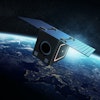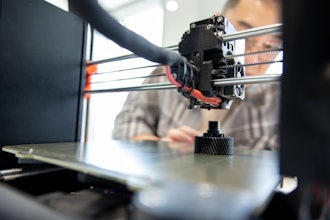
The first metal 3D printer designed for space will soon be tested on the International Space Station (ISS). A collaboration with French metal 3D printer manufacturer AddUp, Airbus, Cranfield University, and Italian aerospace engineering firm Highftech, the printer will be tested on the Columbus module as a preliminary effort that could eventually lead to 3D printing being used for manufacturing in space and on missions to the moon or Mars. The program was funded by the European Space Agency (ESA), according to Airbus.
The ISS is already home to a number of plastic 3D printers—the first one arrived nearly ten years ago—and astronauts use additive manufacturing to replace and repair parts. Despite advances in plastics, the materials can't do everything, and the logistics of shipping metal parts to space is impractical and expensive. While the raw material will still be shipped to the destination, a metal printer can print a nearly infinite variety of parts. However, as research continues on the use of regolith and other natural resources available on the moon and Mars to 3D print parts, the day could come when we don't even need to ship the raw materials.
Most Read on IEN:
- Scout Motors Starts Construction on Electric SUV Plant
- Polaris, Employee Cited for Reckless Tests
- Podcast: Battery Fire at GM; Snap's Drone Recall; Hallucinating Car Radar
- Cleveland-Cliffs to Shutter Tin Plant After Tariff Ruling
According to Airbus Space Assembly lead engineer Gwenaëlle Aridon, the metal 3D printer will provide new on-orbit manufacturing capabilities, like making load-bearing structural parts. Astronauts will also be able to directly manufacture tools, like wrenches, mounting interfaces and mechanical components.
Still, metal 3D printing in space is much different and challenging than modern terrestrial efforts. For example, metal printers on earth are quite large and housed in labs at least ten square meters. The prototype headed to the ISS needed to be scaled down and is about the size of a washing machine, according to Sébastien Girault, metal 3D printer system engineer at Airbus. The printer's footprint is 80 cm by 70 cm by 40 cm, and Girault says it can make parts nine centimeters high and five centimeters wide. The printer will use stainless steel wire as a feedstock.
The plan is to print four parts in space; each job will take about 40 hours.
 A look inside the first metal 3D printer on the ISS.Airbus
A look inside the first metal 3D printer on the ISS.Airbus
Another challenge is safety. Metal 3D printing is an industrial process that includes a laser that creates a lot of heat. So, the printer is enclosed in a metal box. Still, the melting point of some of these metal alloys can exceed 1,200°C degrees.
Gravity management is also essential, which is why the printer uses a wire-based printing technology that is independent of gravity, unlike powder-based systems.
Fumes are an issue as well because some metal filaments, including stainless steel, can release volatile organic compounds (VOCs) or metal oxides that can be harmful to health. Filters will capture the fumes inside the machine so they don't contaminate the air inside the ISS.





















